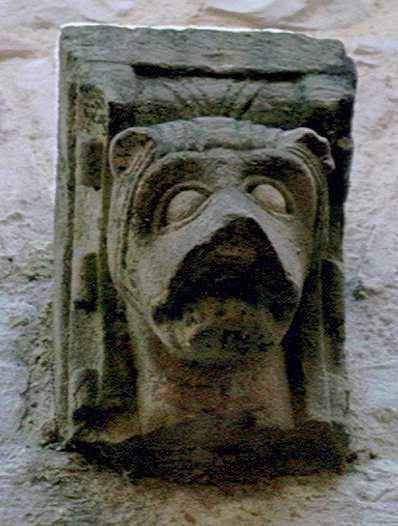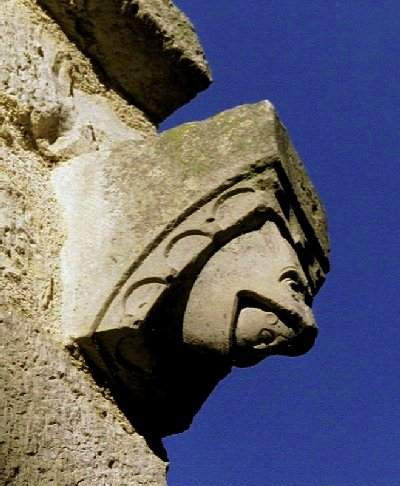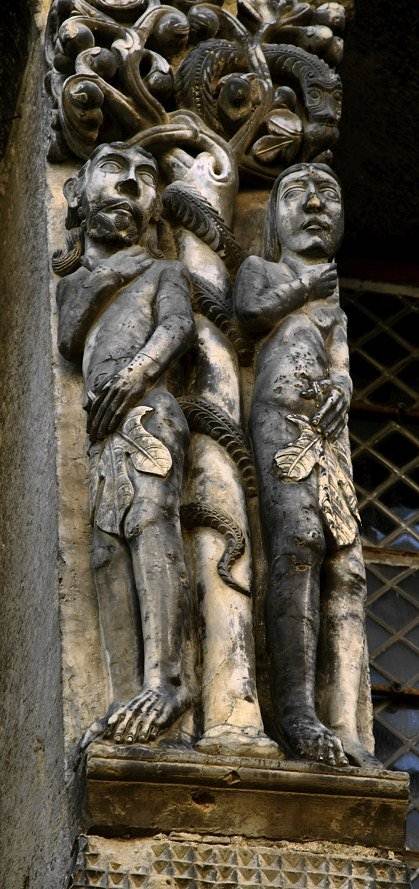

Saint-Antonin-Noble-Val (Tarn-et-Garonne)
Two more corbels from the destroyed abbey on houses at Saint-Antonin:
a lion's head, and a lion (drilled eyes) with a cub in its mouth.
Hell is often represented by a lion's or a monster's jaws swallowing a sinner
(such as an exhibitionist),
often only the head being seen.
But the corbel on the right may well represent Mother Church:
the lioness carrying and protecting her cub.
 |
 |
Adam and Eve on France's oldest surviving civic building of 1125.

|
Anciently known
by its Celtic name of Condate (confluence), legend recounts that
the abbey of Saint-Antonin (Sant Antoní in the suppressed
Occitanian language) was founded in the ninth century in honour of the
saint who brought Christianity to the province of Rouergue. Successful
in this, he decided to convert Pamiers, his home town in the Pyrenees.
But resistance there resulted in his beheading, following which his body
was thrown into the river Ariège. Pious legend recounts that angels
then descended from Heaven to collect the pieces and place them in a boat
which, miraculously, floated downstream into the Garonne and on to where
the Tarn flows into it; then up the Tarn to its confluence with the Aveyron
and up through the Vallis Nobilis of the Aveyron Gorges to the
confluence of the little Bonnette river at a point where the ancient lands
and bishroprics of Rouergue, the Albigeois, and Quercy meet. There the
corpse was retrieved and reassembled by Festus, the Count of Noble-Val,
who placed the relics in a reliquary-shrine.
The Benedictines started rebuilding the abbey in the 11th century, and it was finished around 1150 or even later. By the end of the 12th century it passed into the control of Augustinian Canons Regular. It must have been a very fine and prestigious building, perhaps - to judge from the quality of the carving and the stone of the surviving fragments - one to mention in the same breath as Moissac in the same département. The old town hall (even as mucked about with my Viollet-le-Duc) is also of very high quality. The town was taken by Simon de Montfort in 1212 during the "Albigensian Crusade" or pogrom-extermination of the Cathars, whose castle of Penne a few kilometres downstream was burned by de Montfort and survives now only as a romantic ruin overlooking the river Aveyron. In 1227 St Louis (XI) occupied Saint-Antonin which at this point enjoyed great wealth. The town was besieged and taken by the English in the 14th century, and subsequently suffered considerable damage in the Wars of Religion in the late 16th and again in the early 17th century (former Cathar lands tending towards a Protestantism which survives to this day, for there is a Protestant 'temple' in Saint-Antonin), when the collegiate church and the saintly relics were destroyed by anti-Catholic mobs. It was presumably after the restoration of Catholicism in the town that the corbels were placed on houses without risk of destruction. It was at this time that Louis XIV re-named the town Saint-Antonin-Noble-Val and financed important improvements.
Pèlerinage à l' abbaye réputé au 11e siècle ; coutumes concédées aux habitants entre 1140 et 1144 ; canal, moulin, pont sur l' Aveyron, fortifications existant au milieu du 12e siècle ; porte et fossé mentionnés en 1155 ; le quartier des tanneries s'est urbanisé autour d' un 2e canal au 13e siècle, tandis que les couvents de carmes et de cordeliers s'établissent hors les murs ; expansion économique aux 13e et 14e siècles : en 1328, 2e ville du Rouergue avec 1709 feux ; campagnes importantes entre 1358 et 1363 et après la guerre de Cent Ans ; 2e phase de prospérité après la guerre de Cent Ans qui permet la restauration des édifices endommagés ; la ville passe au calvinisme en 1562 : après le démantèlement de l' abbaye et des couvents ordonné par Blaise de Montluc en 1565, travaux de reconstruction à la fin du 16e siècle, par les ingénieurs César Lacombe et Roaldes et le capitaine Thomet, puis en 1621, 1622 ; fortifications détruites sur ordre du roi après le siège de 1622 ; quartier des tanneries en ruines, en partie rasé après la grande inondation de 1930. |
click
the panel to see a selection of the decorated
and modified Easter Eggs of the Fourth Annual Eggfest.